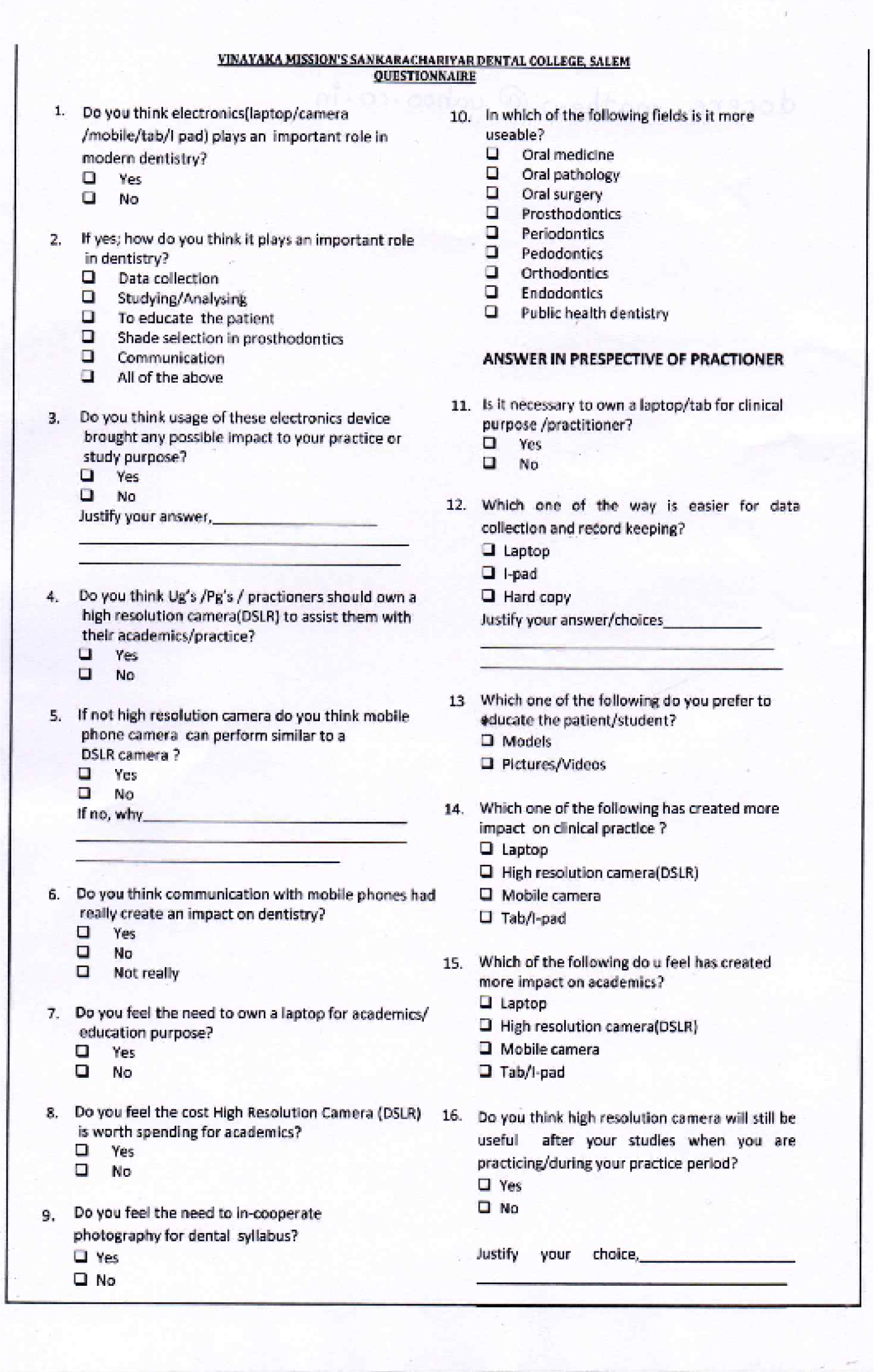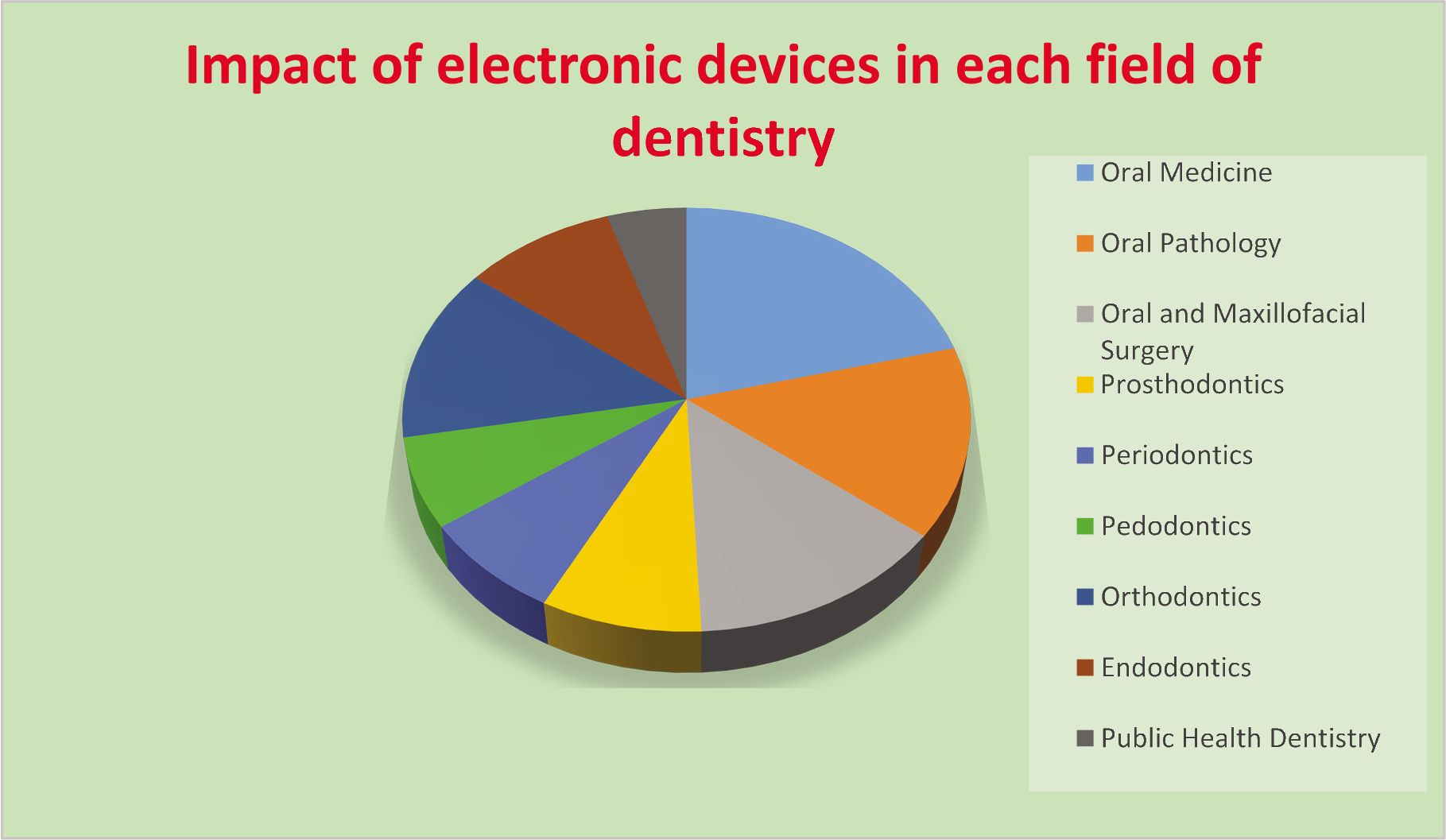Translate this page into:
Impact of Smart Electronic Devices in Contemporary Dentistry- ‘Tech-Knowledge-Y’ in Dentistry
*Address for correspondence:
This article was originally published by Informatics Publishing and was migrated to Scientific Scholar after the change of Publisher.
Abstract
Change is the necessary part of life. In fact, “the only thing constant in the world is-CHANGE". Change happens in every aspect of our lives. In today’s world where digital devices have caused a new era to begin, this has caused a tremendous change in each and every field present. The change from telephone to mobile/smart phone; from letters to email; from hard copy to soft copy form of storage; from low resolution to high resolution camera and so on. The change is drastic. Now the question is will these technologies bring any change in contemporary dentistry? The present article surveys the impact of smart electronic devices in contemporary dentistry.
Keywords
Dentistry
DSLR Camera
Electronic Devices
1. Introduction
With the evolution of smart devices at economical prices to the common man, its dependency has invaded into every aspect of our lives. Professional’s reliance on devices such as scheduling day to day activities and official networking are few examples of its dependency, almost on the verge of addiction. Such an influence is also observed among dentists and aspiring students during the course of their study. A few dental programs around the globe have mandated laptops in the course curriculum. The shift of traditional teaching to contemporary problem based learning requires students to update their knowledge with the current technology and practice of dentistry. In today’s world where there is a great advancement in the field of dentistry, the digital revolution that is transforming every aspect of world, it is also impacting dentistry, medicine in many ways, from electronic record keeping and data analyzing and the revolutionary treatment options1.
2. Aim
To study the impact of electronic devices on contemporary dentistry.
To identify the most commonly used electronic devices in dental field.
To identify the need to incorporate photography in dental syllabus.
3. Methodology
A total of hundred participants which includes undergraduate are students (from first year to internship), postgraduates students and practitioners were included in this study. Students and practitioners were classified into two groups based on exposure to clinical cases. A questionnaire was prepared to be distributed to the students and practitioners and a sample of the questionnaire is shown in Figure 1. All participants were given twenty minutes to answer the questionnaire provided to them. Following which the answers to each question were consolidated and the percentage has been shown in Table 1.

- Questionnaire.
| S.No | QUESTION | UNFAVOURABLE (0-35%) | MIXED (36-65%) | FAVOURABLE (66-100%) | JUSTIFICATION | |
|---|---|---|---|---|---|---|
| 1. | Role of electronic devices in dentistry | 3% | 97% | Easier to collect and manage data. Studying /analysis of cases made easy | ||
| 2. | Impact of electronic devices in dentistry | 12% | 88% | |||
| 3. | Role of DSLR camera in academics and practice. | 28% DSLR has better function than mobile phone | 72% Mobile phones camera can function similar to a DSLR | Recent mobile phones produces images of good clarity and quality but DSLR camera has superior functions. | ||
| 4.` | Role of DSLR after academics. | 37% DSLR is not useful after academics | 63% DSLR can be useful after academics | DSLR camera has better clarity and function and can be useful in every other aspect of life | ||
| 5. | Need to incorporate photography in dental syllabus | 33% | 67% | Gaining basic knowledge about photography would be possible | ||
| 6. | Easier way to collect data | 15% Hardcopy is better way of data collection | 85% Prefers Portable devices | Easy to manage and store data | ||
| 7. | Best method to educate patient and student | 33% Learning through Models | 67% Visualization through videos and pictures | |||
| 8. | Type of Electronic device which has impact on academic and clinics. | 62% Portable devices | Portable devices are easy to carry around and to store data. Mobiles phone helps in communication with patients and cameras in mobile phones is useful for taking photos. |
|||
| 22% Mobile phones | ||||||
| 16% DSLR camera | ||||||
| 9. | Impact of electronic device in each field | 22% Prosthodontics | 55%-Oral Medicine | |||
| 20% Periodontics | ||||||
| 18% Pedodontics | ||||||
| 35% Orthodontics | 38% - Oral Pathology | |||||
| 25% Endodontics | ||||||
| 13% Public health dentistry | ||||||
4. Discussion
The electronic revolution, referred to as the technological or industrial revolution has completely changed the entire world. It is no doubt that without the help of most electronic devices it is impossible to accomplish most of our daily task efficiently and dentistry is not an exception when it comes to electronic revolution. Electronic devices such as laptops, digital cameras, mobile phones, tablets have influenced our lives to such an extent that we cannot work efficiently without them.
In our study, participants were asked to answer questions in the survey, structured to obtain an unbiased opinion of students and staff in application of electronic devices including smartphones and its utility in various aspects of managing and communication with patients. Most participants including staff favored the inclusion of electronic devices in the practice of dentistry as is seen in the Table 1 and have been discussed in the subsequent paragraphs.
Impact of electronic devices on contemporary dentistry is huge and to validate this statement, many undergraduates, post-graduates students and practitioner have agreed that laptops have been very useful to assist them in collection and management of data’s of patient and cases as can been seen in Table 1. Moreover, it helps in studying and analyzing cases, treatment planning and education of patient. Also, easy visualization of pictures and videos with the evolution of CBCT, laptop is a must have tool to assist a practitioner.
Apart from laptops, smart phones also have great influence in modern dentistry. It is a valuable tool without which communication with patient would be burdensome. 69% of the participants, i.e., students and practitioners felt communication with smart phones had really created an impact on dentistry. With the help of smart phone devices, communications with patient such as appointment making has been made easy. Communication among dentists and lab assistants also became easy with the help of mobile phone. A million thanks to Alexander Graham bell for the invention of telephone. Nowadays, most mobile phone also have 2-in-1 function in which can function as camera with hardware and software settings that enable dentists to take photographs at a professional level. The appearance of hard and soft tissues present in oral cavity may be quickly and easily photographed with the help of cameras, thus facilitating the communication among dentist, physician and laboratory2. 72% of participant who took part in this questionnaire thinks that mobile phones can function as a camera to visually record clinical features almost on par to high resolution cameras.
Although, many have agreed that DSLR has far more superior and more advanced function compared to mobile phone cameras, they are comfortable with using mobile phones camera because of its reasonable price. According to undergraduates and postgraduate’s students, the cost of DSLR is too high and if one could afford the cost of DSLR, then the cost is justified as it produces images with better quality and clarity3.
Result obtained from the questionnaire suggest that electronic devices mentioned above plays a major role in studying and analysis, treatment planning, collection of datas and photos of cases which gets referred to Oral medicine and radiology, followed by oral pathology, orthodontics, oral and maxillofacial surgery and other speciality of dentistry (Figure 2).

- Impact of dentistry in each speciality of dentistry.
To achieve a good digital dental photograph, standardization is very important, i.e., consistent lighting, exposure, patient positioning, perspective, depth of field and background2. Therefore, students and practitioner also believe that incorporating photography as a subject into dental syllabus would benefit the upcoming dental graduates. Incorporating photography as a subject would definitely help students to take better pictures as they would have some basic knowledge about photography which will eventually help them in their private practices or further studies later on4.
5. Conclusion
With the advancements, software customizations and “user-friendliness” of electronic devices, professionals in all fields are dependent on so called smart devises to perform optimally, including dentists. The present survey was conducted based on observations of dependency of electronic devises by dentists in private practices and students in the academic realm. The survey showed that staff and students did acknowledge the presence of smart devices and its potential role in private practice and academics.
References
- A multidisciplinary inspection of dental photography: What do dentist think and what can designer do? The Design Journal. 2017;20(1):S1989-97.
- [Google Scholar]
- Digital dental photography: A contemporary revolution. Int J Clin Pediatr Dent. 2013;6(3):193-6.
- [PubMed] [PubMed Central] [Google Scholar]
- Importance of digital dental photography in the practice of dentistry. Sci J Faculty Med in Nis. 2010;27(2):75-9.
- [Google Scholar]






